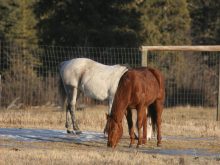Lumpy jaw and wooden tongue are similar in that they both attack tissues in cattle’s mouths and cause swelling, but otherwise they are completely different.
Lumpy jaw is caused by the fungus Actinomyces bovis, which is why it’s called Actinomycosis. If something pierces the lining of the mouth, it opens a door for the fungus to move in.
The fungus prefers to grow in bone, creating tumour-like swellings filled with yellow pus. The swellings can become large, eventually draining small amounts of sticky pus containing gritty yellow granules. This is a slowly progressive disease and can take months to get to this stage.
Chewing can become difficult and painful when it occurs in the lower jaw and the animal loses condition. If lumpy jaw affects the nasal bones, the first sign may be difficult breathing because the swellings block the airways.
Though antifungal medications kill the fungus, treatment is often ineffective because thick walls and exudates surrounding the organism prevent penetration of the medication.
At best, the disease’s progression can be arrested. If lesions are small, surgery can be considered. The pockets are emptied, flushed and packed with iodine sponges.
Slaughter is the most economical way to handle an animal with lumpy jaw. This should be done early so that the animal is still in good condition. As long as the disease is confined to the head (it’s sometimes seen in the intestines), that is the only part that will be condemned.
Wooden tongue, in contrast, is caused by a bacterium. Actinobacillosis lives in the mouth of the host and, like actinomycosis, invades tissues through breaks in the mucous membranes.
Dry, stalky feed, coarse hay and prickly brush can cause mouth abrasions that allow entry of the infection. Wooden tongue is often tied to dry conditions or drought.
It is a rapidly developing, soft tissue disease, affecting the tongue and the lymph nodes of the head. The tongue becomes swollen, hard and painful and often protrudes between the lips, causing the animal to drool.
Nodules and ulcers may appear on the sides of the tongue. Affected animals can’t eat or drink and there is rapid loss of condition. However, as the disease becomes chronic, fibrous tissue forms in the tongue and it becomes hard, shrunken and immobile – thus the term wooden tongue.
The lymph nodes at the back of the jaw can swell up to the size of a football. They consist of thick-walled abscesses that break open and discharge a creamy pus containing yellow granules. If these abscesses occur internally, they can be mistaken for tuberculosis.
Wooden tongue must be treated early for best results. Iodine therapy is the most effective method. The first dose is given intravenously, followed by injections under the skin. Treatment with a sulfa antibiotic is also reported to work. If the animal is not able to drink, tubing with fluids may be necessary to prevent dehydration.
Advanced cases may need surgical draining and flushing. The disease can relapse so all treated animals should be observed after treatment.
Both diseases are contagious. Disinfection of feed and water troughs is advised. If the feed can be changed from hay to silage, it can mean less mouth damage and hopefully fewer new cases.
















